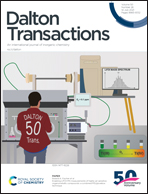Coordination-induced emission enhancement in copper(i) iodide coordination polymers supported by 2-(alkylsulfanyl)pyrimidines†
Abstract
First examples of copper(I) complexes with 2-(alkylsulfanyl)pyrimidine ligands have been synthesized. Reactions of copper(I) iodide with 2-(methylsulfanyl)pyrimidine (L1) in various metal-to-ligand molar ratios in MeCN afford a ladder-type coordination polymer [Cu2L1I2]n with polymeric chains built from double-stranded (Cu2I2)n ribbons supported on both sides by μ2-N,S-L1 molecules. Although the second ligand, 2-(ethylsulfanyl)pyrimidine (L2), differs from L1 only by a methylene group, its reactions with copper(I) iodide in MeCN yield not only a congenerous coordination polymer, [Cu2L2I2]n, but also [CuL2I]n, in which a similar (Cu2I2)n ribbon is decorated by N-monodentate L2 molecules. Absorption spectra of all compounds represent an interplay of metal + iodine-to-ligand charge transfer (XMLCT) and ligand-centered (LC) and cluster-centered (CC) transitions, while the emission occurs from the excited states of XMLCT nature. The luminescence of [Cu2L1I2]n and [Cu2L2I2]n is blue-shifted and greatly enhanced in comparison with that of [CuL2I]n (quantum yields: 89% and 68% for [Cu2L1I2]n and [Cu2L2I2]nvs. 23% for [CuL2I]n at 77 K), which can be associated with a more rigid μ2-N,S coordination of 2-(alkylsulfanyl)pyrimidine ligands in [Cu2L1I2]n and [Cu2L2I2]n leading to a less distorted T1 state.



 Please wait while we load your content...
Please wait while we load your content...